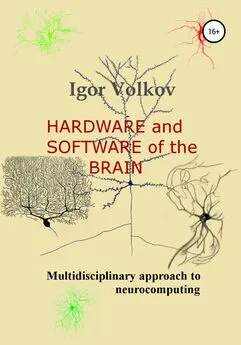Igor Volkov - Hardware and software of the brain
- Название:Hardware and software of the brain
- Автор:
- Жанр:
- Издательство:неизвестно
- Год:2022
- ISBN:нет данных
- Рейтинг:
- Избранное:Добавить в избранное
-
Отзывы:
-
Ваша оценка:
Igor Volkov - Hardware and software of the brain краткое содержание
Hardware and software of the brain - читать онлайн бесплатно ознакомительный отрывок
Интервал:
Закладка:
Two types of continuous computation are visible right away. In the second case, the system is placed into real-world conditions where external events come permanently so some reactions will be generated permanently too. In the first, we can use an image retrieved from autoassociative memory as a key for the next operation. This implements "free thinking" or "flight of ideas".
A computer comes with a ready set of instructions. The set of elementary, hardware-supported actions for a neurocomputer is smaller. This resembles the situation with fonts. The first typewriters had fixed sets. Then, they were replaced by graphics and fonts are usually generated by software now.
Science doesn't use the term software in application to living systems. Researchers study behavior instead. There is even a separate branch called behaviorism. It regards the nervous system as a black box and tries to formulate laws which link its inputs and outputs. The goal of brain research is seemingly to establish how different structures participate in generation of complex behavior. The task turned out to be tricky. The primitive approach is to determine correspondence between elementary actions and various parts of the nervous system. This encountered resistance from the opposite group which claimed that it is impossible and any function is equally distributed over the brain as a whole. For a computer engineer, the solution is obvious. Mapping is possible, but it is internal rather than external actions which should be mapped. Such as memory read/write operations.
The brain as a whole may be best approximated as a finite-state automaton, but this approach has one problem. Neural activity is highly dynamic and requires energy consumption. If you change the state and relax, it will always slip into the zero state. This issue is resolved using a specific architecture of neural nets. Karl Pribram in his "Languages of the brain" highlighted that many connections in the nervous system are reciprocal (bidirectional). If the biofeedback is negative, this serves for stabilization. If it is positive, this will create a generator which can maintain an activity once it was launched. As a result, you may look at an object, then close your eyes, but the image will remain and you even will be able to examine its details.
Abstract neurocomputer
Our computers are based on a Turing machine. Its principle is very simple. Complexity of computers comes from software, not from hardware. The same should be true for the human brain. The problem is that there are no tape and read/write head inside the human scull. Then, what is the prototype for the Turing model? Thorough consideration reveals that he formalized work of a human which uses some external storage such as paper. This approach resembles what is known in neuroscience as behaviorism. It doesn't try to penetrate into the head, regards the brain as a black box with inputs and outputs. What we need now – to describe how this box operates inside.
The first hint comes already from the input signal. Turing supposed that this is text while for the brain it is video. Speech and written textual input emerge only later in biological evolution and human civilization. Neurophysiological study shows that topology of an input image is retained well into the deep parts of visual analyzer so we can conclude that the format of 2D images is the main data format of brain hardware. The next principle is determined by the type of memory used. For any processor, memory input/output is one of the most important operations simply because a processor should process some data and data is stored in memory. The Von Neumann processor uses linear memory, that is a sequence of bytes which are accessed by their address. The human brain has associative memory instead. An elementary block uses a 2d (or 3D) array (millions) of neurons where information is represented by the pattern of activity. The image may be retrieved only as a whole, but this storage is still efficient because a single block can retain many different images. The method of retrieval uses a key which is also some image.
These two principles – a 2D image instead of a byte and associative instead of linear memory may be used as an axiomatic foundation of mathematical neurocomputing. The science may theoretically explore all the possible methods of data processing and all the possible constructs of neuro-machines. Meanwhile the brain is a ready working solution optimized by the nature so we can add further details from data gathered by biological experiments. The next striking difference between common computers and a neurocomputer is the absence of the clock generator. A live neurocomputer is asynchronous. Brain rhythms are well described, but alpha-rhythm of the visual cortex emerges when eyes are closed. Instead, activation is manifested by desynchronization. This creates a major problem. At each step of its operation, a computer should decide what to do next. A neurocomputer should decide when in addition. On the other hand, this feature creates additional flexibility and it is used. Human computations are based on insight. It is well known as a source for great discoveries, but indeed is used on routine basis in tens, maybe hundreds per day. The principle of a computer: take the next instruction from memory at the next pulse of a clock generator. In a neurocomputer, associative memory provides an appropriate idea at an appropriate moment.This sounds like the Holy Grail, but unfortunately this formula contains a lot of uncertainty. More specifically, insight is: 1. generated by hardware that is has no psychological explanation, 2. heavily dependent on previous experience. There are two types of insight: sensory and motor, that is related to input (perception) and output (action). These images are generated in different parts of the neocortex, but subjectively we feel them similarly because all the neocortex has almost the same structure like computer memory. Insights of the first type are especially interesting because they have an explanation from the theory of information. Visual input conveys digital-analog data which according to Shannon's formula contains a virtually infinite amount of information. The nervous system is simply unable to process it all so only some portions are captured when appropriate.
How are insights generated? This is related to another problem. The brain has memory for sure, but does it have a processor?
Theory of neurocomputing
Hardware and software are just parts of another item – a whole computational system and it is obvious that a computer based on the Von Neumann architecture and the human brain are very different. Paradox is that computers were thoroughly developed for decades and we know them in details while evolution of the brain spans millions of years, we use it permanently, but have no clues about its operation. Substantial efforts were made during 19 and 20 centuries so as to fill this gap. Let's try to formulate explicitly the most basic principles of neurocomputing. First, we need to determine our goal. What is a neurocomputer? Any construct created of neural nets? Their range would be as wide as diversity of live nervous systems. Let's confine our interest to the human brain, but keep in mind that it isn't the top of perfectness. Maybe the brain of some animals is better in some aspect. Maybe there are better solutions unknown in the nature. The prototype is only a hint for the theory.
Let's formulate the answer at the very beginning, then explain it in details. Thorough consideration shows that the following 3 concepts are workable for both types of computing, but they have different implementation. Moreover, distribution of overall computing between memory, a processor, and software is different. A neurocomputer uses associative memory implemented as blocks of homogeneous neural nets. Even in the simplest form with 2 layers, they are already capable of some processing such as branching or simple arithmetic (addition and subtraction). That's it. We have processing without a processor. Add the difference in data representation. Computer memory stores data immediately. In neural nets, data is an image represented as a pattern of neural activity, but memory is kept in modifiable synapses. Nets don't store images immediately. They store the ability to generate particular images in response to particular keys. This entails another difference. In a computer, data is loaded from memory into a processor, undergo modification, then is stored back. In a neurocomputer, images are processed immediately in the memory. Elementary processor instructions are replaced by hard-wired ability of a particular block of memory to perform particular image transformations. This ability is defined by local interconnections within the same layer or between different layers of the same net. In a computer it corresponds to some procedure or algorithm which implements a particular method of data processing. On the other hand, each homogeneous net working as heteroassociative memory keeps associations between input and output images. This corresponds to rules of traditional programming, only blocks of those rules are kept in different, genetically predetermined hardware locations. You see that in a neurocomputer, the main paradigm is rule-based and types of rules are predetermined at hardware level.
So does a neurocomputer have a processor? Seemingly, yes, but it is striped of many functions known for its counterpart in a computer. Basically, if we regard the neocortex as the memory, the role of a processor will be to activate or suppress different areas and links between them. A good example is attention. That is, a processor of a neurocomputer accepts various signals from outside and inside the brain, but its output is just internal "turn on" or "turn off". Meanwhile there is something else. Software may be further subdivided into applications, system-level, and firmware (hardware emulation). While the first part is associated with the neocortex and constitutes various externally visible human abilities, the last is stored in a processor. Here we encounter an interesting turn. We have already seen that the memory of a neurocomputer is capable of processing. On the other hand, its processor is made of similar blocks of associative memory. Only now processing is regarded as a main function while memory provides storage for system programming.
Subcortical nuclei of the brain are well described both anatomically and functionally. Many of them provide low-level control which is unrelated to the psyche and behavior. Others are a part of motor and sensory systems. For example, the thalamus is a major relay station which conducts signals from sensory organs to the neocortex. It is the remainder that may be regarded as a candidate to the role of a processor. Two main parts may be named: the basal ganglia and the limbic system. Functional study of the basal ganglia hints that this is also memory indeed. Seeking analogy with computers, one can say that the basal ganglia are BIOS – the memory which contains the most basic subroutines. So the only part remains – the limbic system and its blocks are well connected into a functionally complete unit. Only not all of this complex may be regarded as a CPU. The limbic system is usually associated with motivation and emotions. Human motivation is subdivided into 2 absolutely different types which come from different parts of the brain. High-level goals and long-term plans are generated in the frontal neocortex, while biological desires such as hunger – in the hypothalamus. If we put aside such blocks, 2 major structures remain – the hippocampus and the amygdala.
Let's try and figure out how this processor operates in general.
A Turing machine is claimed to be universal. The human brain is even more universal. It can work in the completely analog mode when a person monitors some object and follows its movements. The first thing to do is to determine the class of tasks which the brain processor is used for. The brain as a whole is a regulator so if everything is normal, it may stay in the state of idle run. Despite not sleeping, it may do nothing special, just perform random actions without particular use. An alternative is goal-oriented behavior. That's what is interesting for us. That's when activity becomes highly structured and the processor operates at full power. The typical example is the task to reach some place walking in the city. Other tasks may be described by analogy. Consider manufacturing. The goal is to assemble some product from parts. Performed operations are separate steps or crossroads on the route, only motion happens in virtual space. The method to generate goal-oriented behavior is problem solving. That's the difference. Creativity. A Turing machine is designed to perform ready algorithms, the processor of the brain – to generate algorithms.
Читать дальшеИнтервал:
Закладка:










